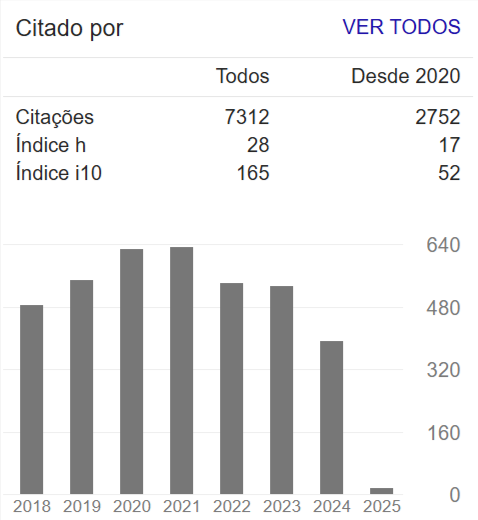Impacts on soil and groundwater and best practice recommendations for shooting ranges
Abstract
Soil and groundwater contamination caused by anthropogenic activities is a complex and costly issue, particularly in shooting ranges, where ammunition residues, upon fragmenting, can pollute the soil and aquifers. Growing awareness of the environmental responsibility of shooting training centers demands the development of strategies to mitigate this pollution and ensure the safety of users and the environment. However, prevention and control measures for this activity remain limited. Facilities using wooden backstops, tires, and earthen berms fail to comply with safety standards, increasing the dispersion of contaminants in the environment, especially heavy metals. The high costs and lengthy recovery times for these areas, particularly when groundwater contamination occurs, underscore the importance of prevention. This study aims to highlight the environmental impacts associated with shooting ranges, particularly on soil and groundwater, and propose best practice recommendations to mitigate these impacts and improve the safety and sustainability of these facilities.
References
ALEMANHA. Gesetz zur Förderung der Kreislaufwirtschaft und Sicherung der umweltverträglichen Bewirtschaftung von Abfällen. 2012. DOI: https://doi.org/10.5771/9783802956317-663 DOI: https://doi.org/10.5771/9783802956317-663
BRASIL. Aperfeiçoamento e padronização da instrução de tiro por forças policiais - estandes de tiro - regulamentação e aspectos construtivos. 2023. Disponível em: https://www.gov.br/mj/pt-br/assuntos/sua-seguranca/seguranca-publica/pro-seguranca/guias-e-estudos-tecnicos/guia-estandes-de-tiro.pdf. Acesso em: 17 dez. 2024.
CDC. Lead (Pb) Poisoning. [s. d.]. 2024. DOI: https://doi.org/10.1037/e411502005-001 DOI: https://doi.org/10.1037/e411502005-001
CHEMELLO, E. Ciência Forense: balística. Química Virtual. p. 1-9, 2007.
CHRISTOU, A.; DALIAS, P.; DEMETRIOU, E.; CHRISTOFIDOU, M.; KOZAKOU, S.; MICHAEL, N.; CHARALAMBOUS, C.; HATZIGEORGIOU, M.; CHRISTOU, E.; STEFANI, D.; CHRISTOFOROU, E.; NEOCLEOUS, D. Lead contamination of soils, sediments, and vegetation in a shooting range and adjacent terrestrial and aquatic ecosystems: A holistic approach for evaluating potential risks. Chemosphere, v. 292, 2022. DOI: https://doi.org/10.1016/j.chemosphere.2021.133424 DOI: https://doi.org/10.1016/j.chemosphere.2021.133424
SOUZA, V. Avaliação da contaminação do solo por metais tóxicos (cádmio, cromo, chumbo e alumínio) em estandes de tiro no estado do Paraná/Brasil. Tese (Doutorado em Ambiente e Desenvolvimento) - Centro Universitário UNIVATES. Rio Grande do Sul: Porto Alegre, 2016. DOI: https://doi.org/10.29381/0103-8559/2020300182-6 DOI: https://doi.org/10.29381/0103-8559/2020300182-6
SOUZA, V.; KONRAD, O.; GONÇALVES JUNIOR, A. C. Exposição por chumbo dos profissionais de segurança pública na região de Cascavel-PR. Revista Verde de Agroecologia e Desenvolvimento Sustentável, v. 10, n. 4, p. 47-53, 2015. DOI: http://dx.doi.org/10.18378/rvads.v10i4.3626 DOI: https://doi.org/10.18378/rvads.v10i4.3626
ESTADOS UNIDOS. National Institute for Occupational Safety and Health - NIOSH. About NIOSH. Disponível em: https://www.cdc.gov/niosh/index.html. Acesso em: 23 out. 2024.
ESTADOS UNIDOS. Occupational Safety and Health Standards - OSHA. About OSHA. Disponível em: https://www.osha.gov/. Acesso em: 23 out. 2024.
EUROPA. Directive 2000/60/EC of the European Parliament and of the Council of 23 October 2000 establishing a framework for Community action in the field of water policy. 2000. DOI: https://doi.org/10.1017/cbo9780511610851.056
EUROPA. Directive 2008/98/EC of the European Parliament and of the Council. 2008. DOI: https://doi.org/10.1017/cbo9780511610851.056 DOI: https://doi.org/10.1017/CBO9780511610851.056
FAHRENHORST, C.; RENGER, M. The effects of very large amounts of lead, antimony and arsenic in agricultural soils in the vicinity of shooting ranges. Journal article: Verband Deutscher Landwirtschaftlicher Untersuchungs- und Forschungsanstalten, n. 32, p. 827-830, 1990. Disponível em: https://www.vdlufa.de/. Acesso em: 17 dez. 2024
FLØTRE, C. H.; VARSI, K.; HELM, T.; BOLANN, B.; BJØRKE-MONSEN, A. Predictors of mercury, lead, cadmium and antimony status in Norwegian never-pregnant women of fertile age. PLoS ONE, v. 12, n. 12, p. e0189169, 2017. DOI: https://doi.org/10.1371/journal.pone.0189169 DOI: https://doi.org/10.1371/journal.pone.0189169
HARCLERODE. M. A.; LAL, P.; VEDWAN, N.; WOLDE, B.; MILLER, M. E. Evaluation of the role of risk perception in stakeholder engagement to prevent lead exposure in an urban setting. Journal of Environmental Management, v. 184, p.132-142, 2016. DOI: https://doi.org/10.1016/j.jenvman.2016.07.045 DOI: https://doi.org/10.1016/j.jenvman.2016.07.045
KAJANDER, S.; PARRI, A. Management of the environmental impact of shooting ranges. Best Available Techniques, The Finnish Enviroment, v. 4, 2014. Disponível em: https://ym.fi/julkaisut. Acesso em: 21 out. 2024.
INSTITUTO SOU DA PAZ. Dados de clubes de tiro no Brasil via Lei de Acesso à Informação – 2023. [S. l.]: Instituto Sou da Paz, 2023. DOI: https://doi.org/10.22478/ufpb.1981-0695.2017v12n1.33788 DOI: https://doi.org/10.22478/ufpb.1981-0695.2017v12n1.33788
ITRC. Characterization and Remediation of Soils at Closed Small Arms Firing Ranges. Washington, D.C.: Interstate Technology & Regulatory Council, 2003. Disponível em: https://itrcweb.org/wp-content/uploads/2024/09/SMART-1.pdf. Acesso em: 21 out. 2024.
KORTE, N. E. Zero-Valent Iron Permeable Reactive Barriers: A Review of Performance. United States, 2001. DOI: https://doi.org/10.2172/814389 DOI: https://doi.org/10.2172/814389
LI, P.; KARUNANIDHI, D.; SUBRAMANI, T.; SRINIVASAMOORTHY, K. Sources and Consequences of Groundwater Contamination. Archives of environmental contamination and toxicology, v. 80, n. 1, p. 1-10, 2021. DOI: https://doi.org/10.1007/s00244-020-00805-z DOI: https://doi.org/10.1007/s00244-020-00805-z
MARIUSSEN, E.; LJØNES, M.; STRØMSENG, A. Use of sorbents for purification of lead, copper and antimony in runoff water from small arms shooting ranges. Journal of Hazardous Materials, v. 243, p. 95-104, 2012. DOI: https://doi.org/10.1016/j.jhazmat.2012.10.005 DOI: https://doi.org/10.1016/j.jhazmat.2012.10.005
NI, S.; RAHMAN, S.; KASAI, S.; YOSHIOKA, S.; WONG, K. H.; MASHIO, A. S.; HASEGAWA, H. Remediation of lead-contaminated shooting range soil: Biodegradable chelator-assisted washing and subsequent post-treatment using FeCl and CaO. Environmental Technology & Innovation, v. 31, 2023. DOI: https://doi.org/10.1016/j.eti.2023.103172 DOI: https://doi.org/10.1016/j.eti.2023.103172
NSSF. Environmental Aspects of Construction and Management of Outdoor Shooting Ranges. 1997. 139 p. Disponível em: https://www.nssf.org/. Acesso em: 29 out. 2024.
NSSF. Why Your Range Should be Using HEPA Filter. 2017. Disponível em: https://www.nssf.org/articles/why-your-range-should-be-using-hepa-filters/. Acesso em: 29 out. 2024.
OKKENHAUG, G.; GEBHARDT, K. A. G.; AMSTAETTER, K.; BUE, H.L.; HERZEL, H.; MARIUSSEN, E.; ALMÅS, Å. R.; CORNELISSEN, G.; BREEDVELD, G.D.; RASMUSSEN, G.; MULDER, J. Antimony (Sb) and lead (Pb) in contaminated shooting range soils: Sb and Pb mobility and immobilization by iron based sorbents, a field study. J Hazard Mater, v. 307, p. 336-43, 2016. DOI: https://doi.org/10.1016/j.jhazmat.2016.01.005 DOI: https://doi.org/10.1016/j.jhazmat.2016.01.005
OLMEZ, I.; KOTRA, J. P.; LOWERY, S.; ZOLLER, W. H. Airborne lead and trace elements in an indoor shooting range: A study of the DC National Guard armory pistol range. Environmental Toxicology and Chemistry, v. 4, p. 447-452, 1985. DOI: https://doi.org/10.1002/etc.5620040404 DOI: https://doi.org/10.1002/etc.5620040404
OMS. Envenenamento por chumbo mata cerca de 1 milhão de pessoas todos os anos. Organização Mundial da Saúde. 2022. Disponível em: https://news.un.org/pt/story/2022/10/1804252#:~:text=A%20cada%20ano%2C%20cerca%20de,elemento%20qu%C3%ADmico%20podem%20ser%20irrevers%C3%ADveis. Acesso em: dia Out. 2024.
RAABE, S. Bullet recycler gets lead out. Denver Post. 2007.
RODRÍGUEZ-SEIJO, A.; LAGO-VILA, M.; ANDRADE, M. L.; VEGA, F. A. Pb pollution in soils from a trap shooting range and the phytoremediation ability of Agrostis capillaris. Enviromental Science and Pollution Research, v. 23, p. 1312–1323, 2016. DOI: https://doi.org/10.1007/s11356-015-5340-7 DOI: https://doi.org/10.1007/s11356-015-5340-7
SÁNCHEZ-CASTRO, I.; MOLINA, L.; PRIETO-FERNÁNDEZ, M.; SEGURA, A. Past, present and future trends in the remediation of heavy-metal contaminated soil - Remediation techniques applied in real soil-contamination events. Heliyon, v. 9, n. 6, 2023. DOI: https://doi.org/10.1016/j.heliyon.2023.e16692 DOI: https://doi.org/10.1016/j.heliyon.2023.e16692
SANDERSON, P.; QI, F.; SESHADRI, B.; WIJAYAWARDENA, A.; NAIDU, R. Contamination, Fate and Management of Metals in Shooting Range Soils—a Review. Current Pollution, v. 4, p. 175–187, 2018. DOI: https://doi.org/10.1007/s40726-018-0089-5 DOI: https://doi.org/10.1007/s40726-018-0089-5
SHARMA, A.; SACHDEVA, S. Cadmium toxicity and its phytoremediation: A review. International Journal of Scientific and Engineering Research, v. 9, 395–405, 2015. Disponível em: https://www.ijser.org/researchpaper/Cadmium-Toxicity-And-Its-Phytoremediation-A-Review.pdf. Acesso em: 29 out. 2024.
SHARMA, J. K.; KUMAR, N.; SINGH, N. P.; SANTAL, A. R. Phytoremediation technologies and their mechanism for removal of heavy metal from contaminated soil: An approach for a sustainable environment. Frontiers in Plant Science, v. 14, p. 1076876, 2023. DOI: https://doi.org/10.3389/fpls.2023.1076876 DOI: https://doi.org/10.3389/fpls.2023.1076876
SHIN, D. Y.; LEE, S. M.; JANG, Y.; LEE, J.; LEE, C. M.; CHO, E.; SEO, Y. R. Adverse Human Health Effects of Chromium by Exposure Route: A Comprehensive Review Based on Toxicogenomic Approach. International Journal of Molecular Sciences, v. 24, n. 4, p. 3410, 2023. DOI: https://doi.org/10.3390/ijms24043410 DOI: https://doi.org/10.3390/ijms24043410
SORVARI, J.; ANTIKAINEN, R.; KOSOLA, M.; HOKKANEN, P.; HAAVISTO, T. Eco-efficiency in contaminated land management in Finland – Barriers and development needs. Journal of Environmental Management, v. 90, n. 5, p. 1715-1727, 2009. DOI: https://doi.org/10.1016/j.jenvman.2008.11.002 DOI: https://doi.org/10.1016/j.jenvman.2008.11.002
TABELIN, C. B.; IGARASHI, T.; VILLACORTE-TABELIN, M.; PARK, I.; OPISO, E. M.; ITO, M.; HIROYOSHI, N. Arsenic, selenium, boron, lead, cadmium, copper, and zinc in naturally contaminated rocks: A review of their sources, modes of enrichment, mechanisms of release, and mitigation strategies. Science of The Total Environment, v. 645, p. 1522-1553, 2018. DOI: https://doi.org/10.1016/j.scitotenv.2018.07.103 DOI: https://doi.org/10.1016/j.scitotenv.2018.07.103
TAN, H. W.; PANG, Y. L.; LIM. S.; CHONG, W. C. A state-of-the-art of phytoremediation approach for sustainable management of heavy metals recovery. Environmental Technology & Innovation, v. 30, 2023. DOI: https://doi.org/10.1016/j.eti.2023.103043 DOI: https://doi.org/10.1016/j.eti.2023.103043
U.S. EPA. Best management practices for lead at outdoor shooting ranges. New York, 2005. 86 p. Disponível em: https://www.epa.gov/lead/best-management-practices-lead-outdoor-shooting-ranges. Acesso em: 02 out. 2024.
U.S. EPA.. Phytoremediation of Contaminated Soil and Ground Water at Hazardous Waste Sites. EPA/ 540/S-01/500. Office of Research and Development, Washington, 2001. Disponível em: https://www.epa.gov/sites/default/files/2015-06/documents/epa_540_s01_500.pdf. Acesso em: 02 out. 2024.
ZHU, Y.; CHE, R.; TU, B.; MIAO, J.; LU, X.; LI, J.; ZHU, Y.; WANG, F. Contamination and remediation of contaminated firing ranges—an overview. Frontiers in Environmental Science, v. 12, p. 1352603, 2024. DOI: https://doi.org/10.3389/fenvs.2024.1352603 DOI: https://doi.org/10.3389/fenvs.2024.1352603

















